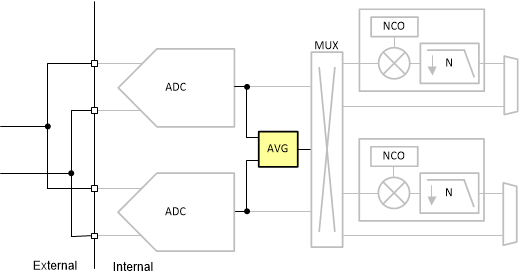ZHCSM31B September 2020 – March 2022 ADC3660
PRODUCTION DATA
- 1 特性
- 2 应用
- 3 说明
- 4 Revision History
- 5 Pin Configuration and Functions
-
6 Specifications
- 6.1 Absolute Maximum Ratings
- 6.2 ESD Ratings
- 6.3 Recommended Operating Conditions
- 6.4 Thermal Information
- 6.5 Electrical Characteristics - Power Consumption
- 6.6 Electrical Characteristics - DC Specifications
- 6.7 Electrical Characteristics - AC Specifications
- 6.8 Timing Requirements
- 6.9 Typical Characteristics
- 7 Parameter Measurement Information
- 8 Detailed Description
- 9 Application and Implementation
- 10Power Supply Recommendations
- 11Layout
- 12Device and Documentation Support
- 13Mechanical, Packaging, and Orderable Information
8.4.3 Digital Channel Averaging
The ADC3660 includes a digital channel averaging feature which enables improvement of the ADC dynamic range (see Figure 8-45). The same input signal is given to both ADC inputs externally and the output of the two ADCs is averaged internally. By averaging, uncorrelated noise (e.g. ADC thermal noise) improves 3-dB while correlated noise (e.g. jitter in the clock path, reference noise) is unaffected. Therefore the averaging gives close to 3-dB improvement at low input frequencies but less at high input frequencies where clock jitter dominates the SNR.
The output from the digital averaging block is given out on the digital outputs of channel A or alternatively can be routed to the digital decimation filters using the digital mux.
 Figure 8-45 Digital Channel Averaging Diagram
Figure 8-45 Digital Channel Averaging Diagram